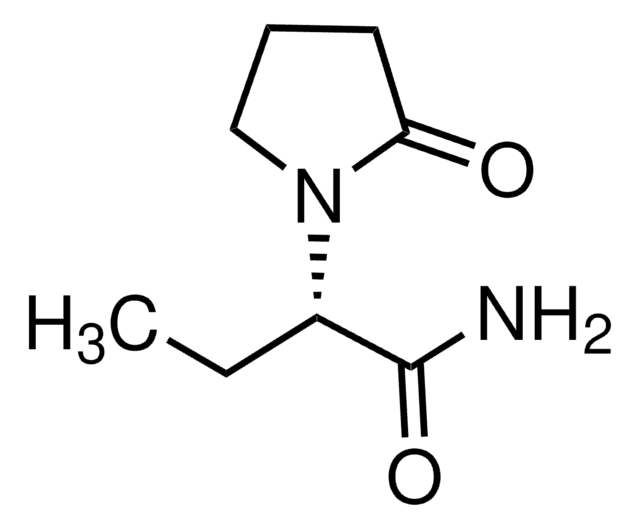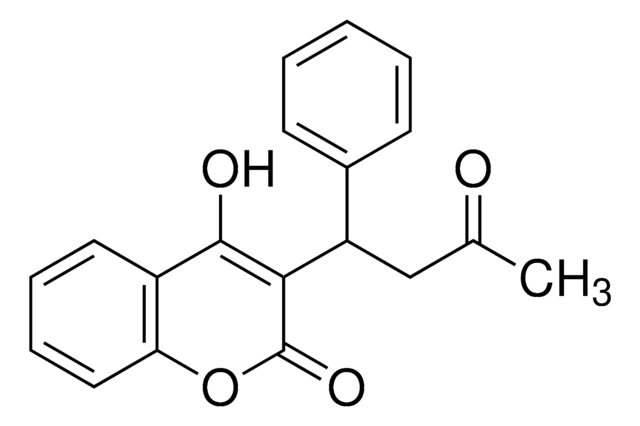SML2468
CINPA1
≥98%
동의어(들):
CAR Inhibitor not PXR Activator 1, Ethyl 5-(2-(diethylamino)acetyl)-10,11-dihydro-5H-dibenzo[b,f]azepin-3-ylcarbamate, [5-[(Diethylamino)acetyl]-10,11-dihydro-5H-dibenz[b,f]azepin-3-yl]carbamic acid ethyl ester
로그인조직 및 계약 가격 보기
모든 사진(1)
About This Item
실험식(Hill 표기법):
C23H29N3O3
CAS Number:
Molecular Weight:
395.49
MDL number:
UNSPSC 코드:
12352200
NACRES:
NA.77
추천 제품
분석
≥98%
양식
powder
색상
white to beige
solubility
DMSO: 2 mg/mL, clear
저장 온도
−20°C
SMILES string
O=C(CN(CC)CC)N1C2=C(C=CC=C2)CCC3=C1C=C(NC(OCC)=O)C=C3
InChI
1S/C23H29N3O3/c1-4-25(5-2)16-22(27)26-20-10-8-7-9-17(20)11-12-18-13-14-19(15-21(18)26)24-23(28)29-6-3/h7-10,13-15H,4-6,11-12,16H2,1-3H3,(H,24,28)
InChI key
AYQBYSPEGRYKFA-UHFFFAOYSA-N
생화학적/생리학적 작용
CINPA1 is a ligand-binding domain (LBD)-targeting constitutive androstane receptor (CAR) inhibitor that prevents CAR recruitment to promoter regions of regulated genes (by >85%; 1 μM CINPA1 against 0.1 μM CITCO-induced CAR recruitment to CYP2B6 or CYP3A4 promoters; human hepatocytes) by altering CAR-coregulator interactions. CINPA1 inhibits CAR-mediated transcription in a potent (IC50 = 70 nM; HepG2-hCAR1 CYP2B6-luc reporter cells) and selective manner with only weak PXR antagonist potency (68% inhibition by 18 μM CINPA1 against 5 μM rifampicin; HepG2-PXR reporter cells) and no cytotoxicity or agonist/antagonist activity toward FXR, GR, LXRα/β, PPARγ, RXRα/β, VDR.
Potent and selective ligand-binding domain (LBD)-targeting constitutive androstane receptor (CAR) inhibitor.
Storage Class Code
11 - Combustible Solids
WGK
WGK 3
Flash Point (°F)
Not applicable
Flash Point (°C)
Not applicable
가장 최신 버전 중 하나를 선택하세요:
Milu T Cherian et al.
Biochemical pharmacology, 152, 211-223 (2018-04-03)
The constitutive androstane receptor (CAR) and pregnane X receptor (PXR) are xenobiotic sensors that regulate the expression of drug-metabolizing enzymes and efflux transporters. CAR activation promotes drug elimination, thereby reducing therapeutic effectiveness, or causes adverse drug effects via toxic metabolites.
Baddreddine Boussadia et al.
Experimental neurology, 283(Pt A), 39-48 (2016-06-01)
Nuclear receptors (NRs) are a group of transcription factors emerging as players in normal and pathological CNS development. Clinically, an association between the constitutive androstane NR (CAR) and cognitive impairment was proposed, however never experimentally investigated. We wished to test
Wenwei Lin et al.
European journal of medicinal chemistry, 108, 505-528 (2015-12-31)
Constitutive androstane receptor (CAR, NR1I3) and pregnane X receptor (PXR, NR1I2) are master regulators of endobiotic and xenobiotic metabolism and disposition. Because CAR is constitutively active in certain cellular contexts, inhibiting CAR might reduce drug-induced hepatotoxicity and resensitize drug-resistant cancer
Milu T Cherian et al.
Drug metabolism and disposition: the biological fate of chemicals, 44(11), 1759-1770 (2016-08-16)
The constitutive androstane receptor (CAR) regulates the expression of genes involved in drug metabolism and other processes. A specific inhibitor of CAR is critical for modulating constitutive CAR activity. We recently described a specific small-molecule inhibitor of CAR, CINPA1 (ethyl
Judith Jeske et al.
Archives of toxicology, 91(6), 2375-2390 (2017-03-16)
Unintentional activation of xenosensing nuclear receptors pregnane X receptor (PXR) and/or constitutive androstane receptor (CAR) by clinical drug use is known to produce severe side effects in patients, which may be overcome by co-administering antagonists. However, especially antagonizing CAR is
자사의 과학자팀은 생명 과학, 재료 과학, 화학 합성, 크로마토그래피, 분석 및 기타 많은 영역을 포함한 모든 과학 분야에 경험이 있습니다..
고객지원팀으로 연락바랍니다.








